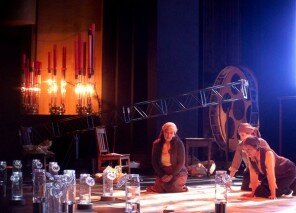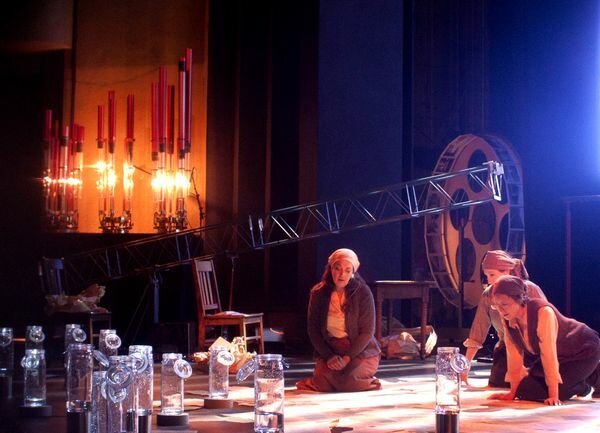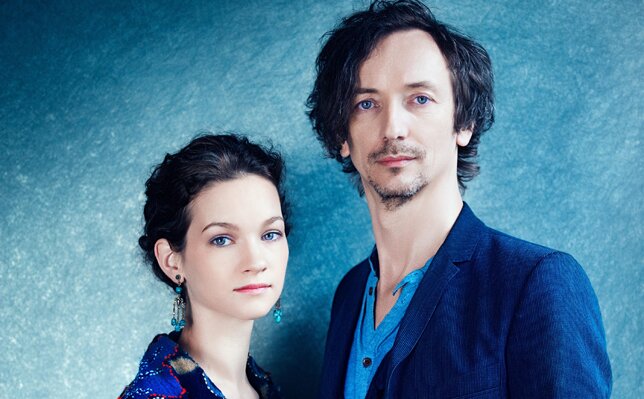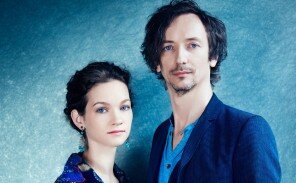Internationally renowned for his innovative sound sculptures, musical compositions, and performance art, Seattle artist Trimpin is back with a multimedia performance honoring prisoners at a World War II labor camp. The Gurs Zyklus premiered at On the Boards last night and features a collection of Trimpin’s sculptures and art installations, including the intriguing “fire organ”. The production continues nightly through Sunday evening.
As a young boy in post-WWII Germany, Trimpin stumbled upon an old Jewish graveyard while playing in the woods outside his hometown, a small village near the French-German border. The haunting experience left him determined to learn more about the fate of the village’s Jewish community during the war. He discovered that the Jews in the area were sent to Gurs, a labor camp in the French Pyranees.
Many years later, Trimpin mentioned his connection to Gurs in an interview for The New Yorker. After the interview was published, he was contacted by Victor Rosenberg, a Jewish-American whose family was imprisoned at the labor camp during the war. In his correspondence with Trimpin, Rosenberg shared letters sent by his family members while they were at Gurs, adding a deeply personal element to Trimpin’s relationship with the labor camp.

The Gurs Zyklus brings Trimpin’s experiences together into a single performance, blending sculpture, music, and theater into a multi-sensory presentation. The hour-long performance centers around Trimpin’s sound sculptures, utilizing each piece to explore a different aspect of the Gurs story. Director Rinde Eckert serves as storyteller, weaving historical facts and personal narratives into the performance. He is joined onstage by vocalists Ellen McLaughlin, Lucia Neare, and Linda Strandberg, whose singing and acting add an operatic element to the production.
Trimpin’s sound sculptures are fascinating contraptions that would be perfectly at home in the laboratory of an eccentric inventor. The mysterious “fire organ” utilizes flame-heated air to sound a collection of organ pipes. Other pieces include a piano played by electromagnetic solenoids and a mini-organ powered by re-purposed computer cooling fans. A work that uses drops of falling water to spell the names of those who died at Gurs is a quietly powerful tribute to all who lost their lives in World War II labor camps.
A simple, understated memorial, The Gurs Zyklus does not overwhelm the audience with elaborate visuals or overwrought drama. Instead, it lets the experiences of the prisoners speak for themselves, creating a rich sensory tribute that is both educational and emotionally moving. The most powerful moments of the performance involve the Rosenberg letters, which are simply read out loud by the performers, accompanied by music from the sound sculptures.
As a theatrical work, The Gurs Zyklus feels cluttered and disjointed at times, zooming quickly through historical references and personal memoirs. In particular, a nod to Spanish poet Federico Garcia Lorca feels a bit random and forced. The three vocalists, onstage during the entire performance, add an important human element to the production, but occasionally their acting and singing feels like an afterthought. At times, it’s difficult to figure out how the pieces fit together into a cohesive whole.
Part sculpture showcase, part theater piece, part musical performance, The Gurs Zyklus is best seen as an artistic exploration of the events, people, and memories that surround the Gurs labor camp. The production provides audiences with a unique way to experience Trimpin’s fascinating artwork while paying tribute to those whose lives were touched by Gurs.



